Infection Control and Prevention Research Assignment, Think Education
VerifiedAdded on 2022/11/26
|21
|4433
|287
Homework Assignment
AI Summary
This research assignment, completed by a student, focuses on infection control and minimizing language barriers in healthcare settings. The assignment begins with an introduction to the topics, outlining the reasons for the research and the research question: 'What are the key strategies of infection prevention in a hospital and a community setting?' The student defines SMART objectives and identifies relevant disciplines and sources, including systematic reviews and literature reviews. The assignment analyzes several articles, comparing their findings and relevance to the research objectives. The student then discusses the practical application of the information, potential areas for workplace change, and topics for further research. The assignment also covers strategies for minimizing language barriers when communicating with clients. The conclusion highlights key strategies such as hand hygiene, the use of personal protective equipment, education, and surveillance for infection control.
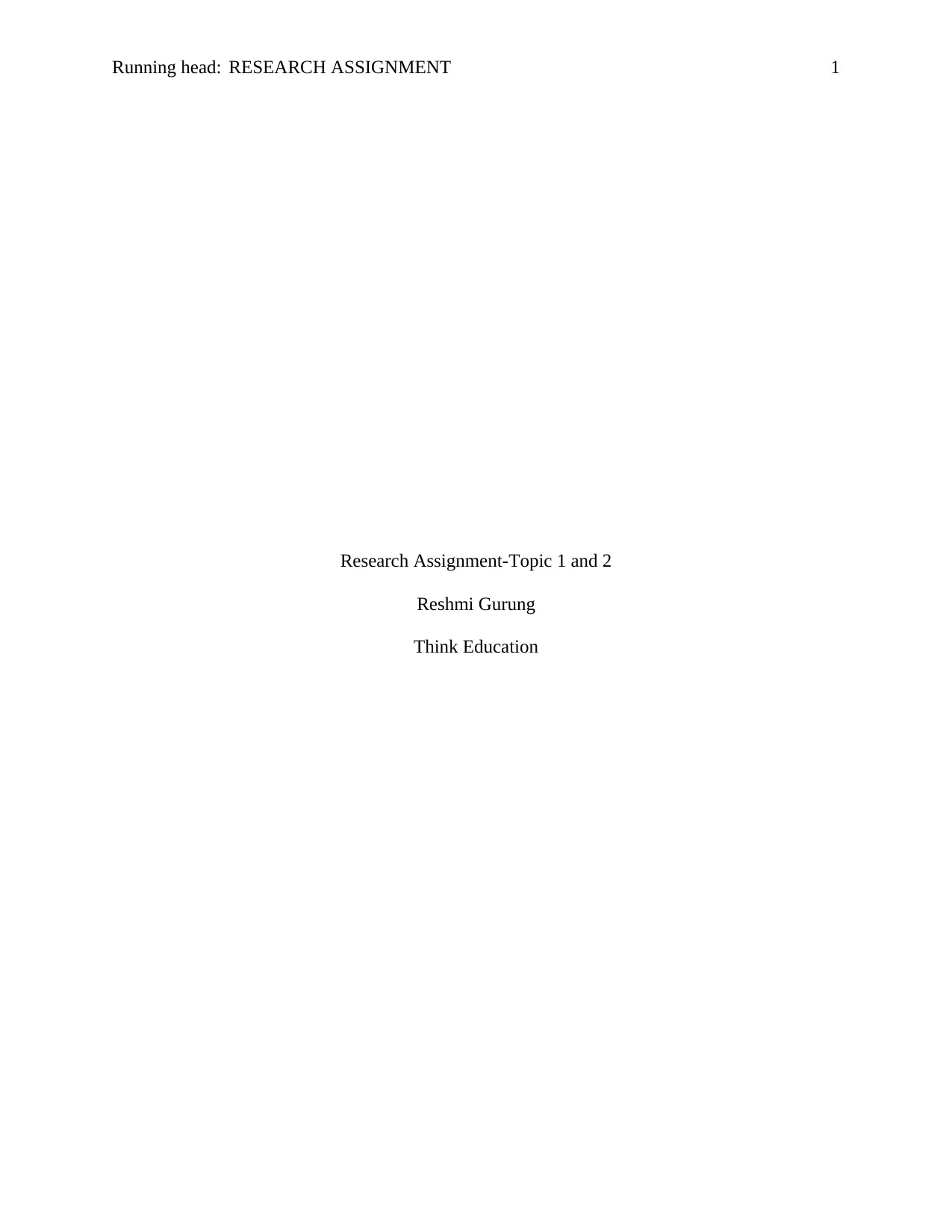
Running head: RESEARCH ASSIGNMENT 1
Research Assignment-Topic 1 and 2
Reshmi Gurung
Think Education
Research Assignment-Topic 1 and 2
Reshmi Gurung
Think Education
Paraphrase This Document
Need a fresh take? Get an instant paraphrase of this document with our AI Paraphraser
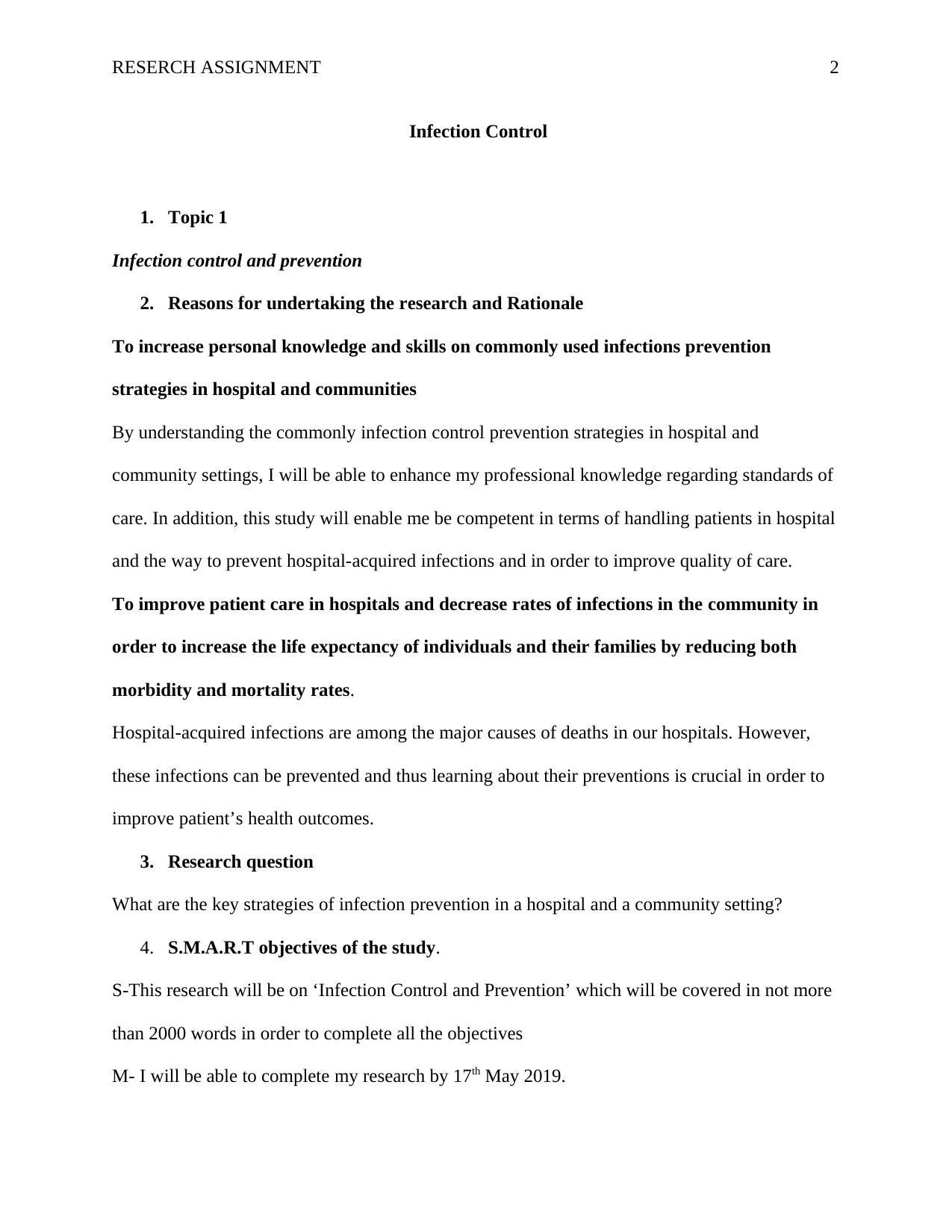
RESERCH ASSIGNMENT 2
Infection Control
1. Topic 1
Infection control and prevention
2. Reasons for undertaking the research and Rationale
To increase personal knowledge and skills on commonly used infections prevention
strategies in hospital and communities
By understanding the commonly infection control prevention strategies in hospital and
community settings, I will be able to enhance my professional knowledge regarding standards of
care. In addition, this study will enable me be competent in terms of handling patients in hospital
and the way to prevent hospital-acquired infections and in order to improve quality of care.
To improve patient care in hospitals and decrease rates of infections in the community in
order to increase the life expectancy of individuals and their families by reducing both
morbidity and mortality rates.
Hospital-acquired infections are among the major causes of deaths in our hospitals. However,
these infections can be prevented and thus learning about their preventions is crucial in order to
improve patient’s health outcomes.
3. Research question
What are the key strategies of infection prevention in a hospital and a community setting?
4. S.M.A.R.T objectives of the study.
S-This research will be on ‘Infection Control and Prevention’ which will be covered in not more
than 2000 words in order to complete all the objectives
M- I will be able to complete my research by 17th May 2019.
Infection Control
1. Topic 1
Infection control and prevention
2. Reasons for undertaking the research and Rationale
To increase personal knowledge and skills on commonly used infections prevention
strategies in hospital and communities
By understanding the commonly infection control prevention strategies in hospital and
community settings, I will be able to enhance my professional knowledge regarding standards of
care. In addition, this study will enable me be competent in terms of handling patients in hospital
and the way to prevent hospital-acquired infections and in order to improve quality of care.
To improve patient care in hospitals and decrease rates of infections in the community in
order to increase the life expectancy of individuals and their families by reducing both
morbidity and mortality rates.
Hospital-acquired infections are among the major causes of deaths in our hospitals. However,
these infections can be prevented and thus learning about their preventions is crucial in order to
improve patient’s health outcomes.
3. Research question
What are the key strategies of infection prevention in a hospital and a community setting?
4. S.M.A.R.T objectives of the study.
S-This research will be on ‘Infection Control and Prevention’ which will be covered in not more
than 2000 words in order to complete all the objectives
M- I will be able to complete my research by 17th May 2019.
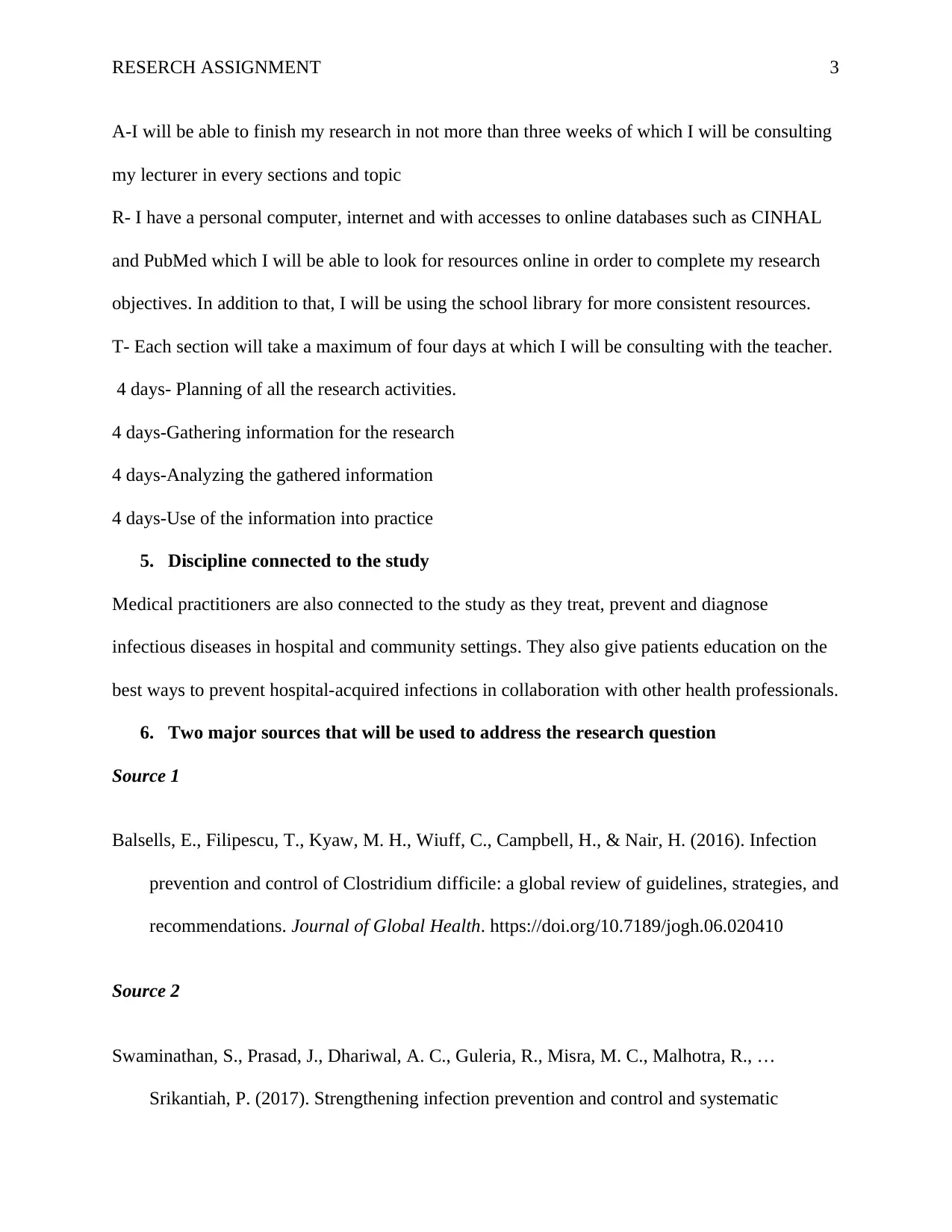
RESERCH ASSIGNMENT 3
A-I will be able to finish my research in not more than three weeks of which I will be consulting
my lecturer in every sections and topic
R- I have a personal computer, internet and with accesses to online databases such as CINHAL
and PubMed which I will be able to look for resources online in order to complete my research
objectives. In addition to that, I will be using the school library for more consistent resources.
T- Each section will take a maximum of four days at which I will be consulting with the teacher.
4 days- Planning of all the research activities.
4 days-Gathering information for the research
4 days-Analyzing the gathered information
4 days-Use of the information into practice
5. Discipline connected to the study
Medical practitioners are also connected to the study as they treat, prevent and diagnose
infectious diseases in hospital and community settings. They also give patients education on the
best ways to prevent hospital-acquired infections in collaboration with other health professionals.
6. Two major sources that will be used to address the research question
Source 1
Balsells, E., Filipescu, T., Kyaw, M. H., Wiuff, C., Campbell, H., & Nair, H. (2016). Infection
prevention and control of Clostridium difficile: a global review of guidelines, strategies, and
recommendations. Journal of Global Health. https://doi.org/10.7189/jogh.06.020410
Source 2
Swaminathan, S., Prasad, J., Dhariwal, A. C., Guleria, R., Misra, M. C., Malhotra, R., …
Srikantiah, P. (2017). Strengthening infection prevention and control and systematic
A-I will be able to finish my research in not more than three weeks of which I will be consulting
my lecturer in every sections and topic
R- I have a personal computer, internet and with accesses to online databases such as CINHAL
and PubMed which I will be able to look for resources online in order to complete my research
objectives. In addition to that, I will be using the school library for more consistent resources.
T- Each section will take a maximum of four days at which I will be consulting with the teacher.
4 days- Planning of all the research activities.
4 days-Gathering information for the research
4 days-Analyzing the gathered information
4 days-Use of the information into practice
5. Discipline connected to the study
Medical practitioners are also connected to the study as they treat, prevent and diagnose
infectious diseases in hospital and community settings. They also give patients education on the
best ways to prevent hospital-acquired infections in collaboration with other health professionals.
6. Two major sources that will be used to address the research question
Source 1
Balsells, E., Filipescu, T., Kyaw, M. H., Wiuff, C., Campbell, H., & Nair, H. (2016). Infection
prevention and control of Clostridium difficile: a global review of guidelines, strategies, and
recommendations. Journal of Global Health. https://doi.org/10.7189/jogh.06.020410
Source 2
Swaminathan, S., Prasad, J., Dhariwal, A. C., Guleria, R., Misra, M. C., Malhotra, R., …
Srikantiah, P. (2017). Strengthening infection prevention and control and systematic
⊘ This is a preview!⊘
Do you want full access?
Subscribe today to unlock all pages.

Trusted by 1+ million students worldwide
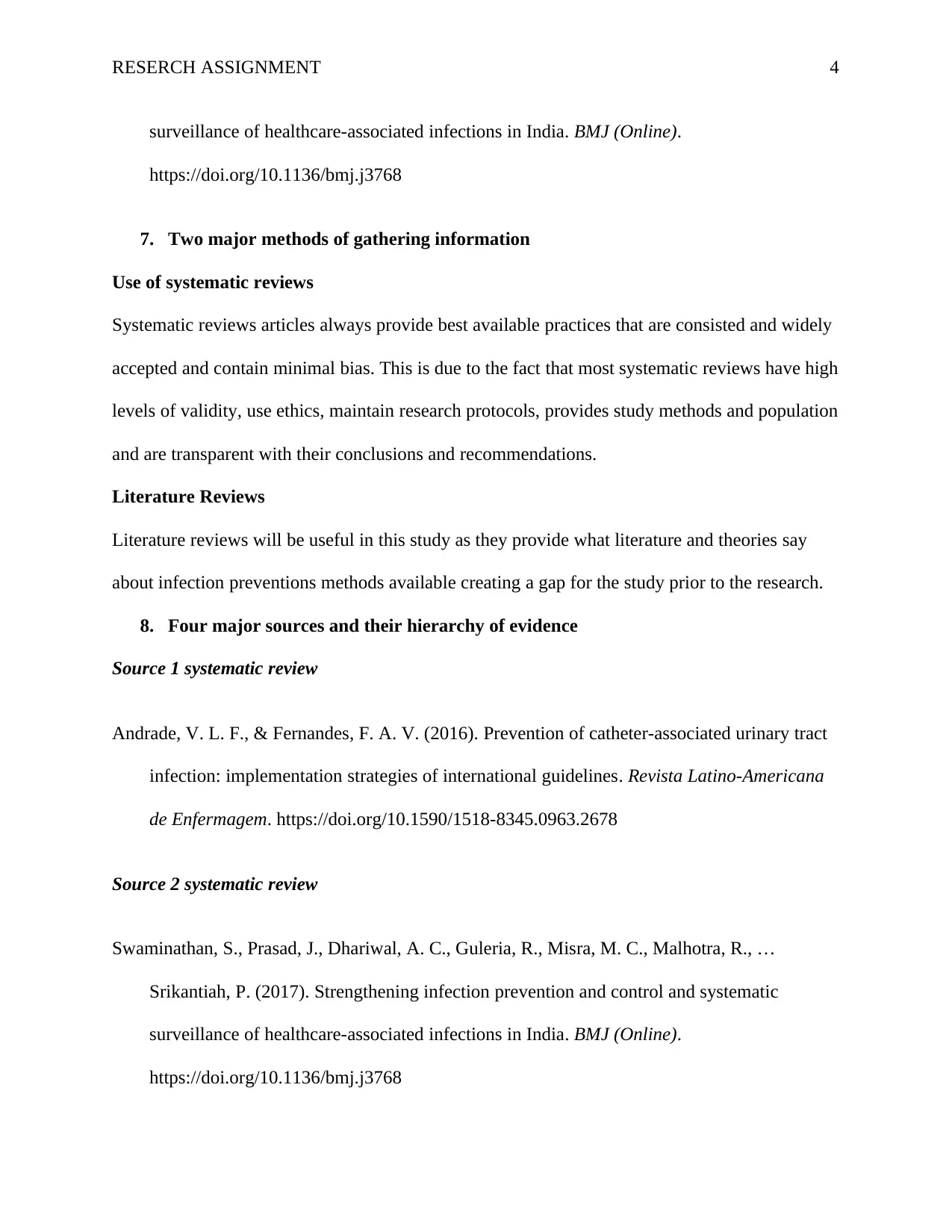
RESERCH ASSIGNMENT 4
surveillance of healthcare-associated infections in India. BMJ (Online).
https://doi.org/10.1136/bmj.j3768
7. Two major methods of gathering information
Use of systematic reviews
Systematic reviews articles always provide best available practices that are consisted and widely
accepted and contain minimal bias. This is due to the fact that most systematic reviews have high
levels of validity, use ethics, maintain research protocols, provides study methods and population
and are transparent with their conclusions and recommendations.
Literature Reviews
Literature reviews will be useful in this study as they provide what literature and theories say
about infection preventions methods available creating a gap for the study prior to the research.
8. Four major sources and their hierarchy of evidence
Source 1 systematic review
Andrade, V. L. F., & Fernandes, F. A. V. (2016). Prevention of catheter-associated urinary tract
infection: implementation strategies of international guidelines. Revista Latino-Americana
de Enfermagem. https://doi.org/10.1590/1518-8345.0963.2678
Source 2 systematic review
Swaminathan, S., Prasad, J., Dhariwal, A. C., Guleria, R., Misra, M. C., Malhotra, R., …
Srikantiah, P. (2017). Strengthening infection prevention and control and systematic
surveillance of healthcare-associated infections in India. BMJ (Online).
https://doi.org/10.1136/bmj.j3768
surveillance of healthcare-associated infections in India. BMJ (Online).
https://doi.org/10.1136/bmj.j3768
7. Two major methods of gathering information
Use of systematic reviews
Systematic reviews articles always provide best available practices that are consisted and widely
accepted and contain minimal bias. This is due to the fact that most systematic reviews have high
levels of validity, use ethics, maintain research protocols, provides study methods and population
and are transparent with their conclusions and recommendations.
Literature Reviews
Literature reviews will be useful in this study as they provide what literature and theories say
about infection preventions methods available creating a gap for the study prior to the research.
8. Four major sources and their hierarchy of evidence
Source 1 systematic review
Andrade, V. L. F., & Fernandes, F. A. V. (2016). Prevention of catheter-associated urinary tract
infection: implementation strategies of international guidelines. Revista Latino-Americana
de Enfermagem. https://doi.org/10.1590/1518-8345.0963.2678
Source 2 systematic review
Swaminathan, S., Prasad, J., Dhariwal, A. C., Guleria, R., Misra, M. C., Malhotra, R., …
Srikantiah, P. (2017). Strengthening infection prevention and control and systematic
surveillance of healthcare-associated infections in India. BMJ (Online).
https://doi.org/10.1136/bmj.j3768
Paraphrase This Document
Need a fresh take? Get an instant paraphrase of this document with our AI Paraphraser
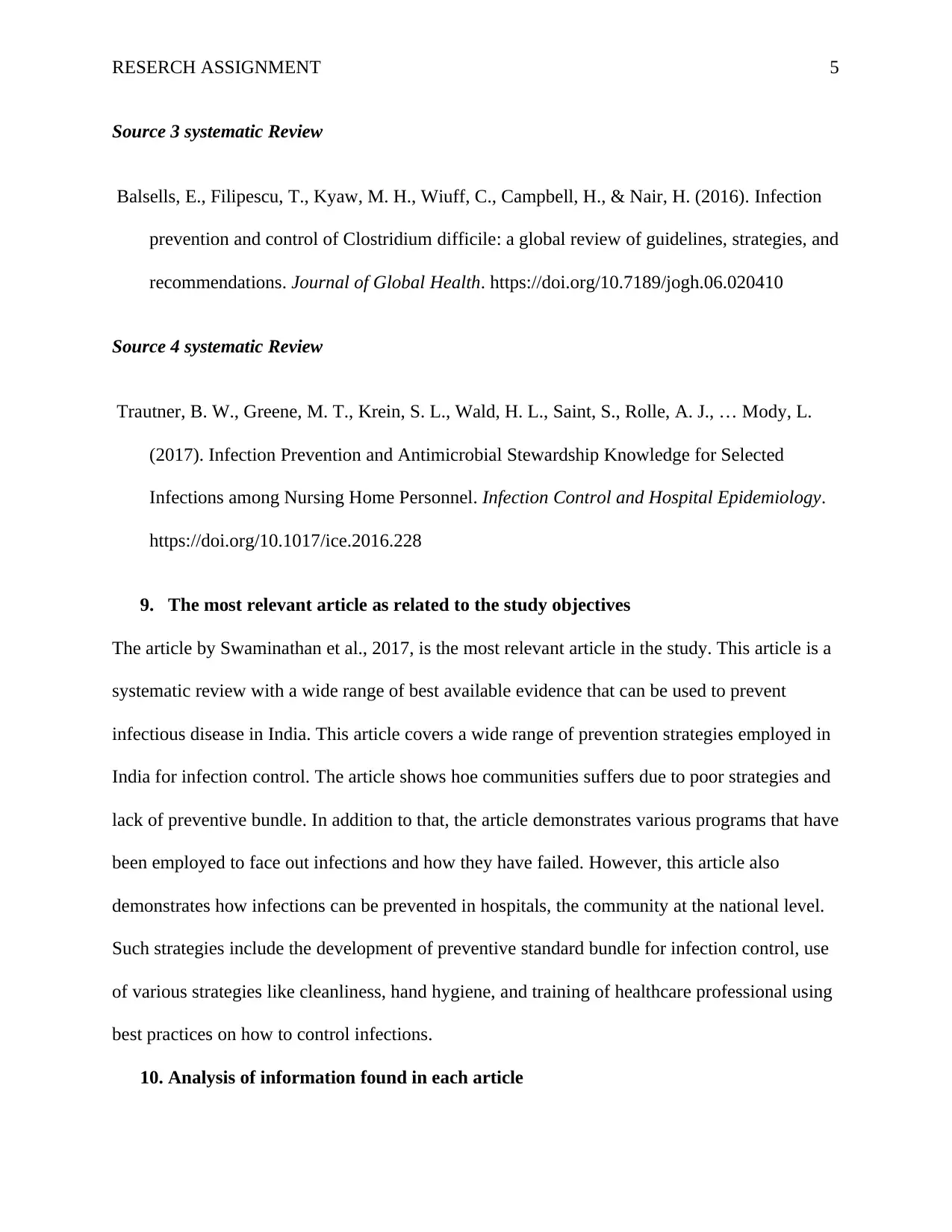
RESERCH ASSIGNMENT 5
Source 3 systematic Review
Balsells, E., Filipescu, T., Kyaw, M. H., Wiuff, C., Campbell, H., & Nair, H. (2016). Infection
prevention and control of Clostridium difficile: a global review of guidelines, strategies, and
recommendations. Journal of Global Health. https://doi.org/10.7189/jogh.06.020410
Source 4 systematic Review
Trautner, B. W., Greene, M. T., Krein, S. L., Wald, H. L., Saint, S., Rolle, A. J., … Mody, L.
(2017). Infection Prevention and Antimicrobial Stewardship Knowledge for Selected
Infections among Nursing Home Personnel. Infection Control and Hospital Epidemiology.
https://doi.org/10.1017/ice.2016.228
9. The most relevant article as related to the study objectives
The article by Swaminathan et al., 2017, is the most relevant article in the study. This article is a
systematic review with a wide range of best available evidence that can be used to prevent
infectious disease in India. This article covers a wide range of prevention strategies employed in
India for infection control. The article shows hoe communities suffers due to poor strategies and
lack of preventive bundle. In addition to that, the article demonstrates various programs that have
been employed to face out infections and how they have failed. However, this article also
demonstrates how infections can be prevented in hospitals, the community at the national level.
Such strategies include the development of preventive standard bundle for infection control, use
of various strategies like cleanliness, hand hygiene, and training of healthcare professional using
best practices on how to control infections.
10. Analysis of information found in each article
Source 3 systematic Review
Balsells, E., Filipescu, T., Kyaw, M. H., Wiuff, C., Campbell, H., & Nair, H. (2016). Infection
prevention and control of Clostridium difficile: a global review of guidelines, strategies, and
recommendations. Journal of Global Health. https://doi.org/10.7189/jogh.06.020410
Source 4 systematic Review
Trautner, B. W., Greene, M. T., Krein, S. L., Wald, H. L., Saint, S., Rolle, A. J., … Mody, L.
(2017). Infection Prevention and Antimicrobial Stewardship Knowledge for Selected
Infections among Nursing Home Personnel. Infection Control and Hospital Epidemiology.
https://doi.org/10.1017/ice.2016.228
9. The most relevant article as related to the study objectives
The article by Swaminathan et al., 2017, is the most relevant article in the study. This article is a
systematic review with a wide range of best available evidence that can be used to prevent
infectious disease in India. This article covers a wide range of prevention strategies employed in
India for infection control. The article shows hoe communities suffers due to poor strategies and
lack of preventive bundle. In addition to that, the article demonstrates various programs that have
been employed to face out infections and how they have failed. However, this article also
demonstrates how infections can be prevented in hospitals, the community at the national level.
Such strategies include the development of preventive standard bundle for infection control, use
of various strategies like cleanliness, hand hygiene, and training of healthcare professional using
best practices on how to control infections.
10. Analysis of information found in each article
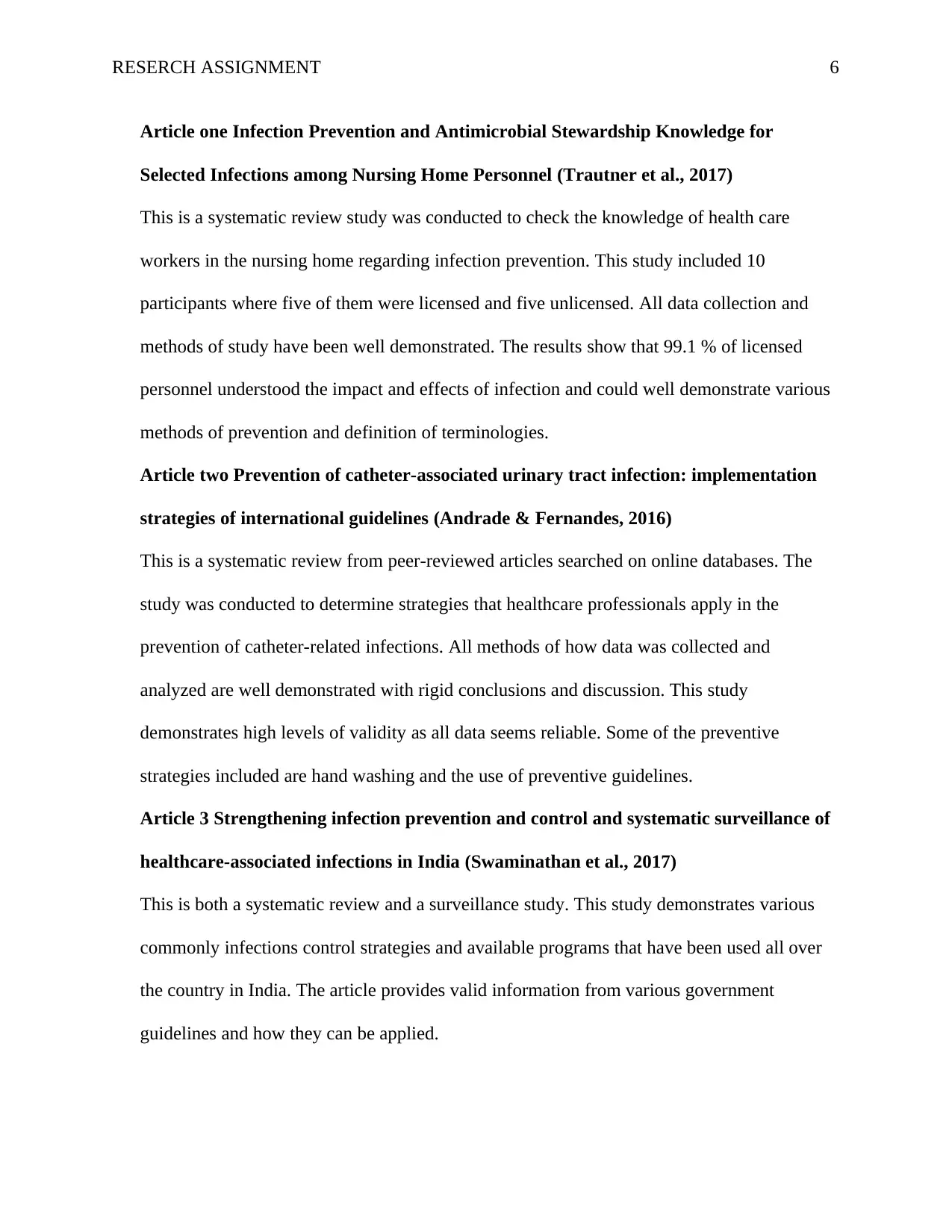
RESERCH ASSIGNMENT 6
Article one Infection Prevention and Antimicrobial Stewardship Knowledge for
Selected Infections among Nursing Home Personnel (Trautner et al., 2017)
This is a systematic review study was conducted to check the knowledge of health care
workers in the nursing home regarding infection prevention. This study included 10
participants where five of them were licensed and five unlicensed. All data collection and
methods of study have been well demonstrated. The results show that 99.1 % of licensed
personnel understood the impact and effects of infection and could well demonstrate various
methods of prevention and definition of terminologies.
Article two Prevention of catheter-associated urinary tract infection: implementation
strategies of international guidelines (Andrade & Fernandes, 2016)
This is a systematic review from peer-reviewed articles searched on online databases. The
study was conducted to determine strategies that healthcare professionals apply in the
prevention of catheter-related infections. All methods of how data was collected and
analyzed are well demonstrated with rigid conclusions and discussion. This study
demonstrates high levels of validity as all data seems reliable. Some of the preventive
strategies included are hand washing and the use of preventive guidelines.
Article 3 Strengthening infection prevention and control and systematic surveillance of
healthcare-associated infections in India (Swaminathan et al., 2017)
This is both a systematic review and a surveillance study. This study demonstrates various
commonly infections control strategies and available programs that have been used all over
the country in India. The article provides valid information from various government
guidelines and how they can be applied.
Article one Infection Prevention and Antimicrobial Stewardship Knowledge for
Selected Infections among Nursing Home Personnel (Trautner et al., 2017)
This is a systematic review study was conducted to check the knowledge of health care
workers in the nursing home regarding infection prevention. This study included 10
participants where five of them were licensed and five unlicensed. All data collection and
methods of study have been well demonstrated. The results show that 99.1 % of licensed
personnel understood the impact and effects of infection and could well demonstrate various
methods of prevention and definition of terminologies.
Article two Prevention of catheter-associated urinary tract infection: implementation
strategies of international guidelines (Andrade & Fernandes, 2016)
This is a systematic review from peer-reviewed articles searched on online databases. The
study was conducted to determine strategies that healthcare professionals apply in the
prevention of catheter-related infections. All methods of how data was collected and
analyzed are well demonstrated with rigid conclusions and discussion. This study
demonstrates high levels of validity as all data seems reliable. Some of the preventive
strategies included are hand washing and the use of preventive guidelines.
Article 3 Strengthening infection prevention and control and systematic surveillance of
healthcare-associated infections in India (Swaminathan et al., 2017)
This is both a systematic review and a surveillance study. This study demonstrates various
commonly infections control strategies and available programs that have been used all over
the country in India. The article provides valid information from various government
guidelines and how they can be applied.
⊘ This is a preview!⊘
Do you want full access?
Subscribe today to unlock all pages.

Trusted by 1+ million students worldwide
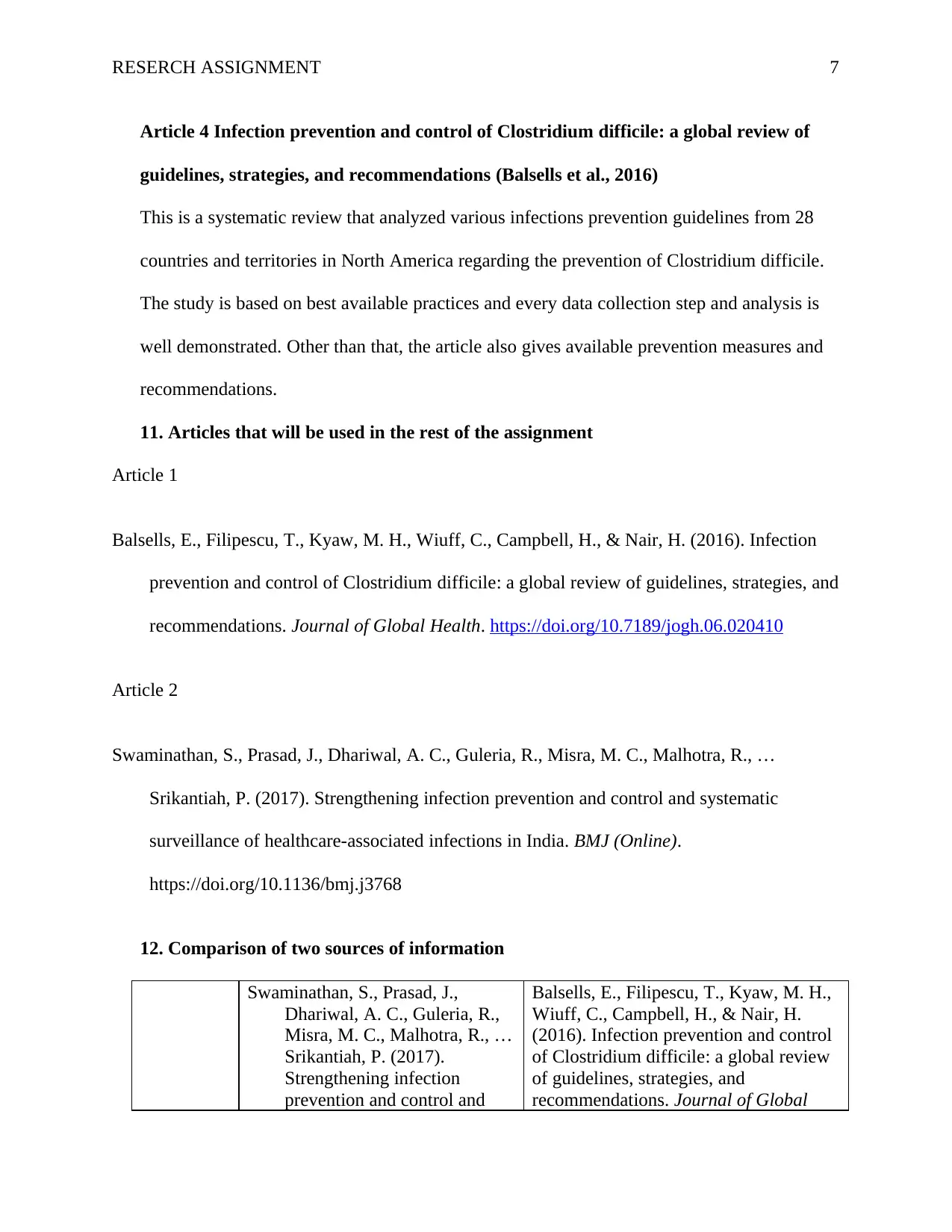
RESERCH ASSIGNMENT 7
Article 4 Infection prevention and control of Clostridium difficile: a global review of
guidelines, strategies, and recommendations (Balsells et al., 2016)
This is a systematic review that analyzed various infections prevention guidelines from 28
countries and territories in North America regarding the prevention of Clostridium difficile.
The study is based on best available practices and every data collection step and analysis is
well demonstrated. Other than that, the article also gives available prevention measures and
recommendations.
11. Articles that will be used in the rest of the assignment
Article 1
Balsells, E., Filipescu, T., Kyaw, M. H., Wiuff, C., Campbell, H., & Nair, H. (2016). Infection
prevention and control of Clostridium difficile: a global review of guidelines, strategies, and
recommendations. Journal of Global Health. https://doi.org/10.7189/jogh.06.020410
Article 2
Swaminathan, S., Prasad, J., Dhariwal, A. C., Guleria, R., Misra, M. C., Malhotra, R., …
Srikantiah, P. (2017). Strengthening infection prevention and control and systematic
surveillance of healthcare-associated infections in India. BMJ (Online).
https://doi.org/10.1136/bmj.j3768
12. Comparison of two sources of information
Swaminathan, S., Prasad, J.,
Dhariwal, A. C., Guleria, R.,
Misra, M. C., Malhotra, R., …
Srikantiah, P. (2017).
Strengthening infection
prevention and control and
Balsells, E., Filipescu, T., Kyaw, M. H.,
Wiuff, C., Campbell, H., & Nair, H.
(2016). Infection prevention and control
of Clostridium difficile: a global review
of guidelines, strategies, and
recommendations. Journal of Global
Article 4 Infection prevention and control of Clostridium difficile: a global review of
guidelines, strategies, and recommendations (Balsells et al., 2016)
This is a systematic review that analyzed various infections prevention guidelines from 28
countries and territories in North America regarding the prevention of Clostridium difficile.
The study is based on best available practices and every data collection step and analysis is
well demonstrated. Other than that, the article also gives available prevention measures and
recommendations.
11. Articles that will be used in the rest of the assignment
Article 1
Balsells, E., Filipescu, T., Kyaw, M. H., Wiuff, C., Campbell, H., & Nair, H. (2016). Infection
prevention and control of Clostridium difficile: a global review of guidelines, strategies, and
recommendations. Journal of Global Health. https://doi.org/10.7189/jogh.06.020410
Article 2
Swaminathan, S., Prasad, J., Dhariwal, A. C., Guleria, R., Misra, M. C., Malhotra, R., …
Srikantiah, P. (2017). Strengthening infection prevention and control and systematic
surveillance of healthcare-associated infections in India. BMJ (Online).
https://doi.org/10.1136/bmj.j3768
12. Comparison of two sources of information
Swaminathan, S., Prasad, J.,
Dhariwal, A. C., Guleria, R.,
Misra, M. C., Malhotra, R., …
Srikantiah, P. (2017).
Strengthening infection
prevention and control and
Balsells, E., Filipescu, T., Kyaw, M. H.,
Wiuff, C., Campbell, H., & Nair, H.
(2016). Infection prevention and control
of Clostridium difficile: a global review
of guidelines, strategies, and
recommendations. Journal of Global
Paraphrase This Document
Need a fresh take? Get an instant paraphrase of this document with our AI Paraphraser
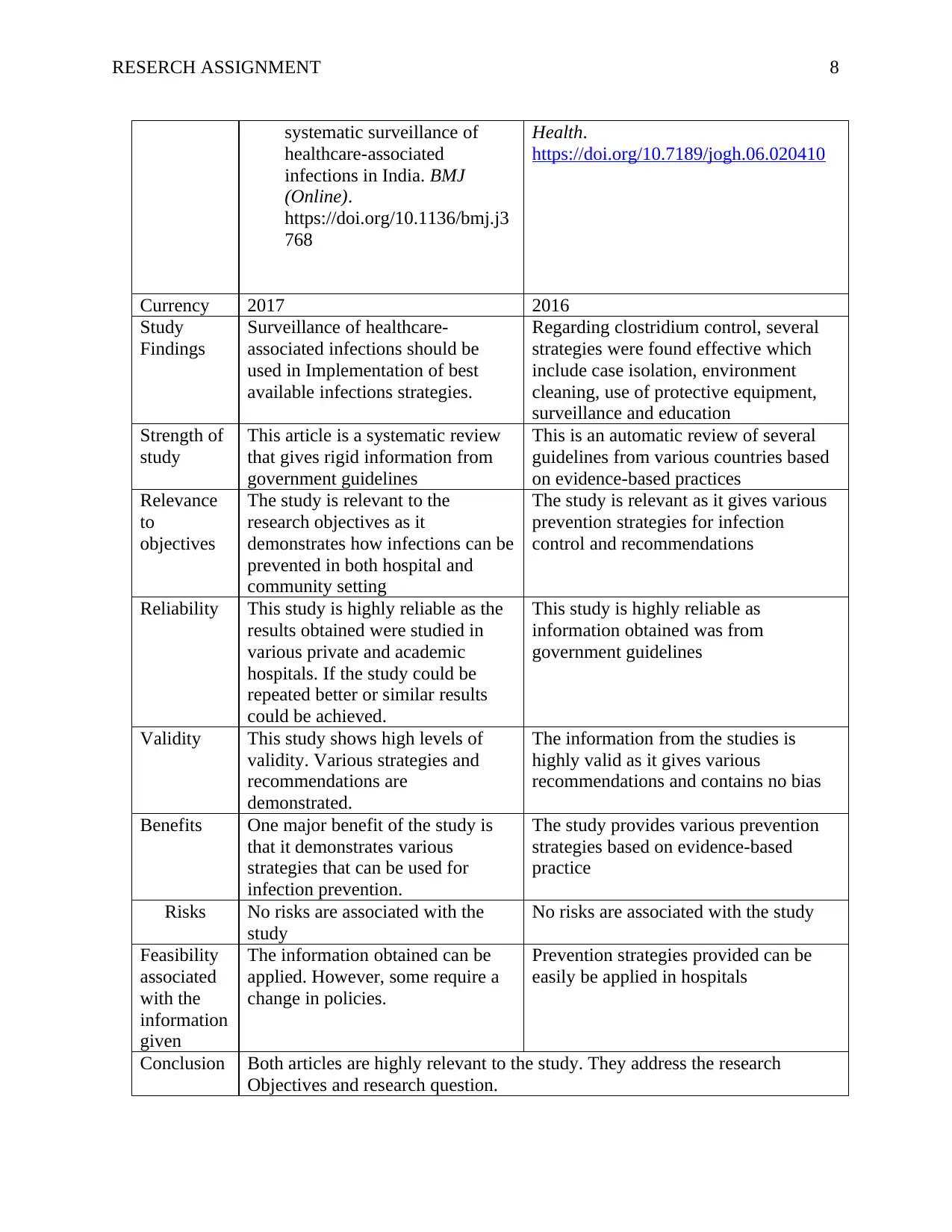
RESERCH ASSIGNMENT 8
systematic surveillance of
healthcare-associated
infections in India. BMJ
(Online).
https://doi.org/10.1136/bmj.j3
768
Health.
https://doi.org/10.7189/jogh.06.020410
Currency 2017 2016
Study
Findings
Surveillance of healthcare-
associated infections should be
used in Implementation of best
available infections strategies.
Regarding clostridium control, several
strategies were found effective which
include case isolation, environment
cleaning, use of protective equipment,
surveillance and education
Strength of
study
This article is a systematic review
that gives rigid information from
government guidelines
This is an automatic review of several
guidelines from various countries based
on evidence-based practices
Relevance
to
objectives
The study is relevant to the
research objectives as it
demonstrates how infections can be
prevented in both hospital and
community setting
The study is relevant as it gives various
prevention strategies for infection
control and recommendations
Reliability This study is highly reliable as the
results obtained were studied in
various private and academic
hospitals. If the study could be
repeated better or similar results
could be achieved.
This study is highly reliable as
information obtained was from
government guidelines
Validity This study shows high levels of
validity. Various strategies and
recommendations are
demonstrated.
The information from the studies is
highly valid as it gives various
recommendations and contains no bias
Benefits One major benefit of the study is
that it demonstrates various
strategies that can be used for
infection prevention.
The study provides various prevention
strategies based on evidence-based
practice
Risks No risks are associated with the
study
No risks are associated with the study
Feasibility
associated
with the
information
given
The information obtained can be
applied. However, some require a
change in policies.
Prevention strategies provided can be
easily be applied in hospitals
Conclusion Both articles are highly relevant to the study. They address the research
Objectives and research question.
systematic surveillance of
healthcare-associated
infections in India. BMJ
(Online).
https://doi.org/10.1136/bmj.j3
768
Health.
https://doi.org/10.7189/jogh.06.020410
Currency 2017 2016
Study
Findings
Surveillance of healthcare-
associated infections should be
used in Implementation of best
available infections strategies.
Regarding clostridium control, several
strategies were found effective which
include case isolation, environment
cleaning, use of protective equipment,
surveillance and education
Strength of
study
This article is a systematic review
that gives rigid information from
government guidelines
This is an automatic review of several
guidelines from various countries based
on evidence-based practices
Relevance
to
objectives
The study is relevant to the
research objectives as it
demonstrates how infections can be
prevented in both hospital and
community setting
The study is relevant as it gives various
prevention strategies for infection
control and recommendations
Reliability This study is highly reliable as the
results obtained were studied in
various private and academic
hospitals. If the study could be
repeated better or similar results
could be achieved.
This study is highly reliable as
information obtained was from
government guidelines
Validity This study shows high levels of
validity. Various strategies and
recommendations are
demonstrated.
The information from the studies is
highly valid as it gives various
recommendations and contains no bias
Benefits One major benefit of the study is
that it demonstrates various
strategies that can be used for
infection prevention.
The study provides various prevention
strategies based on evidence-based
practice
Risks No risks are associated with the
study
No risks are associated with the study
Feasibility
associated
with the
information
given
The information obtained can be
applied. However, some require a
change in policies.
Prevention strategies provided can be
easily be applied in hospitals
Conclusion Both articles are highly relevant to the study. They address the research
Objectives and research question.
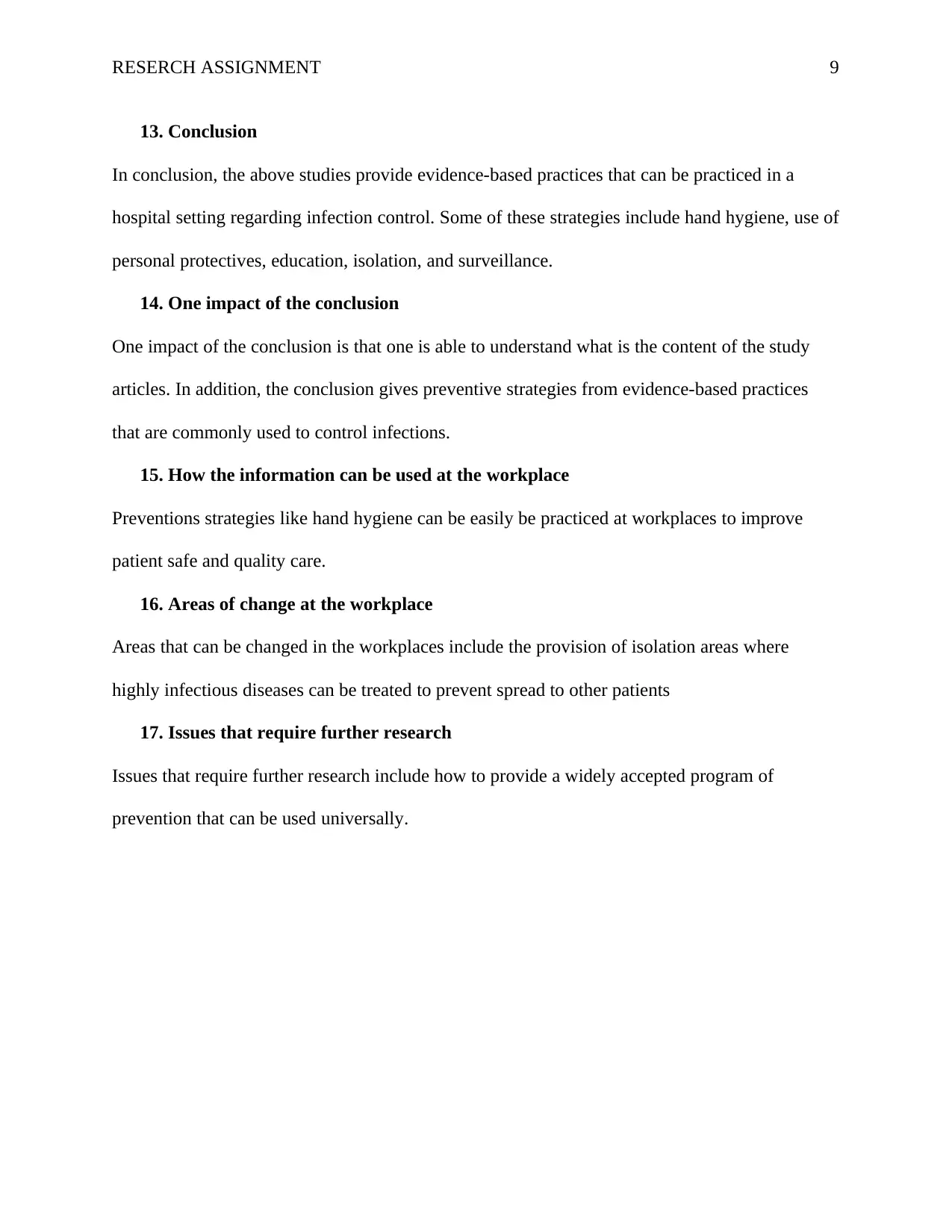
RESERCH ASSIGNMENT 9
13. Conclusion
In conclusion, the above studies provide evidence-based practices that can be practiced in a
hospital setting regarding infection control. Some of these strategies include hand hygiene, use of
personal protectives, education, isolation, and surveillance.
14. One impact of the conclusion
One impact of the conclusion is that one is able to understand what is the content of the study
articles. In addition, the conclusion gives preventive strategies from evidence-based practices
that are commonly used to control infections.
15. How the information can be used at the workplace
Preventions strategies like hand hygiene can be easily be practiced at workplaces to improve
patient safe and quality care.
16. Areas of change at the workplace
Areas that can be changed in the workplaces include the provision of isolation areas where
highly infectious diseases can be treated to prevent spread to other patients
17. Issues that require further research
Issues that require further research include how to provide a widely accepted program of
prevention that can be used universally.
13. Conclusion
In conclusion, the above studies provide evidence-based practices that can be practiced in a
hospital setting regarding infection control. Some of these strategies include hand hygiene, use of
personal protectives, education, isolation, and surveillance.
14. One impact of the conclusion
One impact of the conclusion is that one is able to understand what is the content of the study
articles. In addition, the conclusion gives preventive strategies from evidence-based practices
that are commonly used to control infections.
15. How the information can be used at the workplace
Preventions strategies like hand hygiene can be easily be practiced at workplaces to improve
patient safe and quality care.
16. Areas of change at the workplace
Areas that can be changed in the workplaces include the provision of isolation areas where
highly infectious diseases can be treated to prevent spread to other patients
17. Issues that require further research
Issues that require further research include how to provide a widely accepted program of
prevention that can be used universally.
⊘ This is a preview!⊘
Do you want full access?
Subscribe today to unlock all pages.

Trusted by 1+ million students worldwide
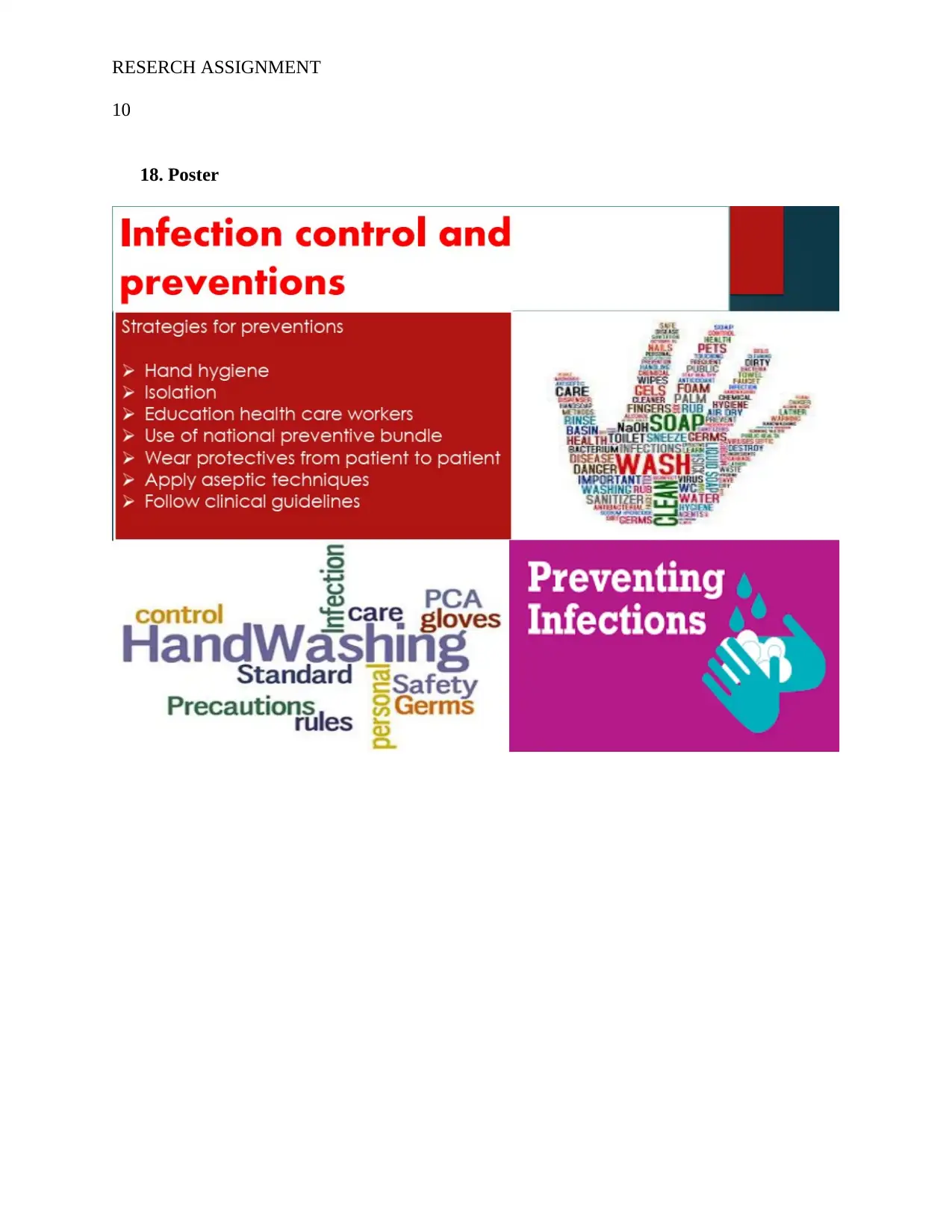
RESERCH ASSIGNMENT
10
18. Poster
10
18. Poster
Paraphrase This Document
Need a fresh take? Get an instant paraphrase of this document with our AI Paraphraser
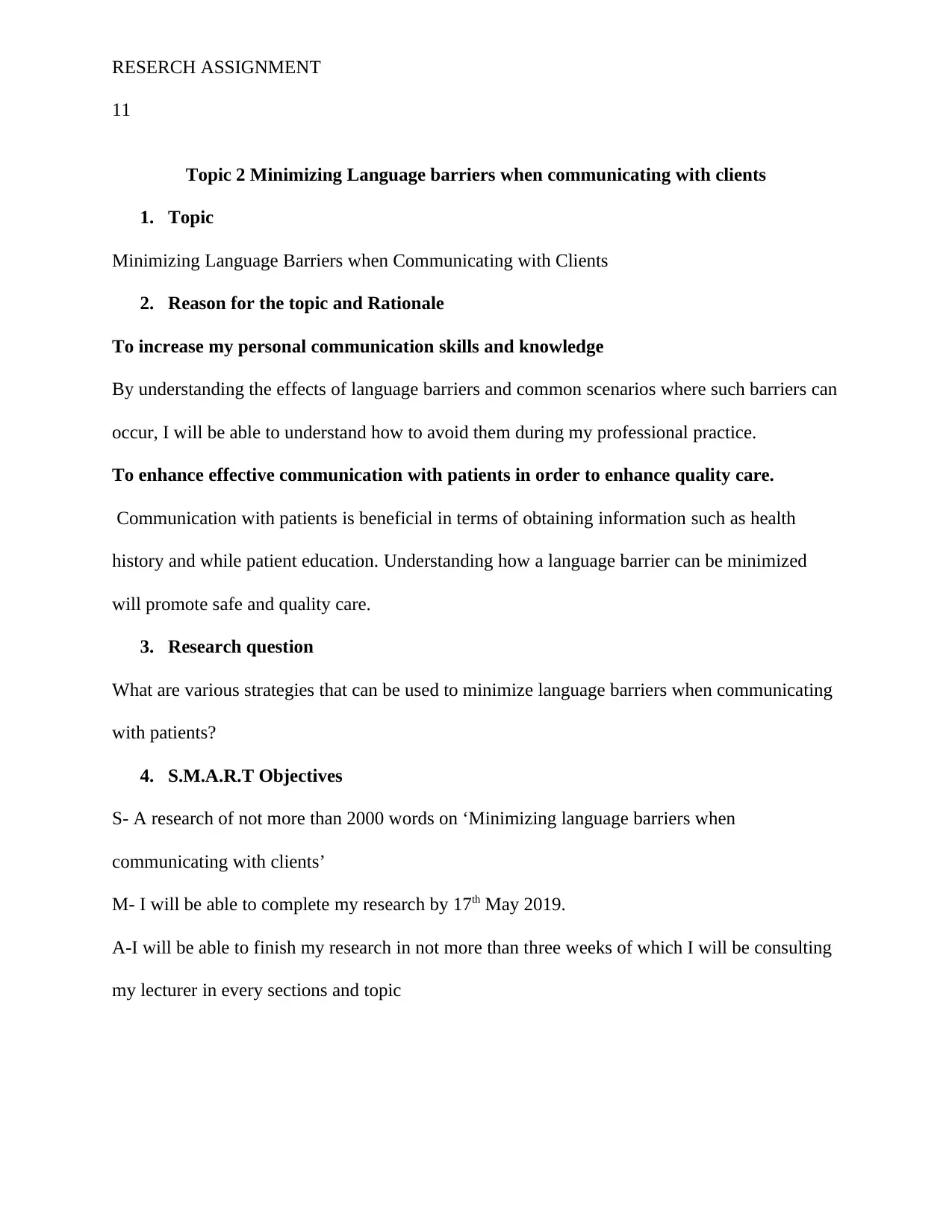
RESERCH ASSIGNMENT
11
Topic 2 Minimizing Language barriers when communicating with clients
1. Topic
Minimizing Language Barriers when Communicating with Clients
2. Reason for the topic and Rationale
To increase my personal communication skills and knowledge
By understanding the effects of language barriers and common scenarios where such barriers can
occur, I will be able to understand how to avoid them during my professional practice.
To enhance effective communication with patients in order to enhance quality care.
Communication with patients is beneficial in terms of obtaining information such as health
history and while patient education. Understanding how a language barrier can be minimized
will promote safe and quality care.
3. Research question
What are various strategies that can be used to minimize language barriers when communicating
with patients?
4. S.M.A.R.T Objectives
S- A research of not more than 2000 words on ‘Minimizing language barriers when
communicating with clients’
M- I will be able to complete my research by 17th May 2019.
A-I will be able to finish my research in not more than three weeks of which I will be consulting
my lecturer in every sections and topic
11
Topic 2 Minimizing Language barriers when communicating with clients
1. Topic
Minimizing Language Barriers when Communicating with Clients
2. Reason for the topic and Rationale
To increase my personal communication skills and knowledge
By understanding the effects of language barriers and common scenarios where such barriers can
occur, I will be able to understand how to avoid them during my professional practice.
To enhance effective communication with patients in order to enhance quality care.
Communication with patients is beneficial in terms of obtaining information such as health
history and while patient education. Understanding how a language barrier can be minimized
will promote safe and quality care.
3. Research question
What are various strategies that can be used to minimize language barriers when communicating
with patients?
4. S.M.A.R.T Objectives
S- A research of not more than 2000 words on ‘Minimizing language barriers when
communicating with clients’
M- I will be able to complete my research by 17th May 2019.
A-I will be able to finish my research in not more than three weeks of which I will be consulting
my lecturer in every sections and topic
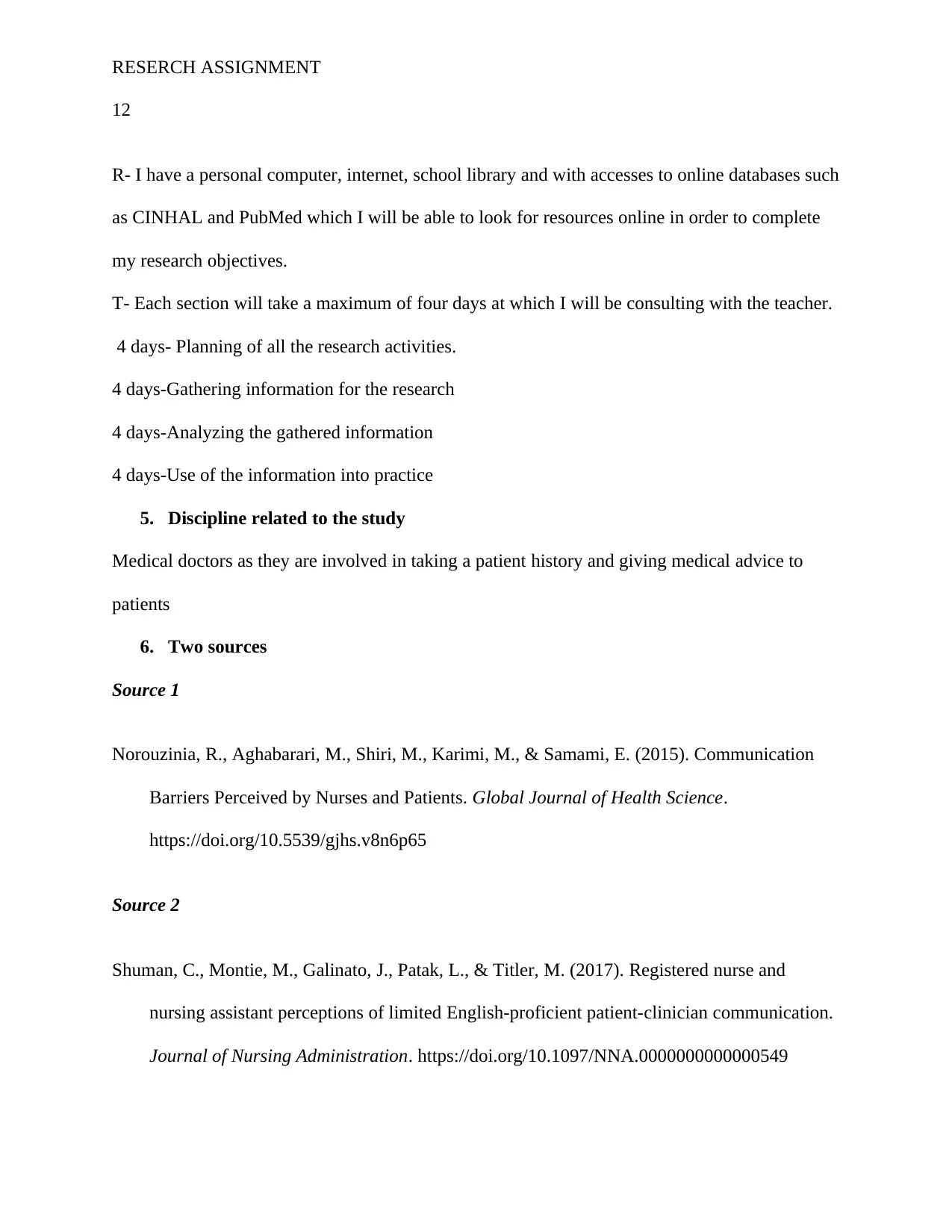
RESERCH ASSIGNMENT
12
R- I have a personal computer, internet, school library and with accesses to online databases such
as CINHAL and PubMed which I will be able to look for resources online in order to complete
my research objectives.
T- Each section will take a maximum of four days at which I will be consulting with the teacher.
4 days- Planning of all the research activities.
4 days-Gathering information for the research
4 days-Analyzing the gathered information
4 days-Use of the information into practice
5. Discipline related to the study
Medical doctors as they are involved in taking a patient history and giving medical advice to
patients
6. Two sources
Source 1
Norouzinia, R., Aghabarari, M., Shiri, M., Karimi, M., & Samami, E. (2015). Communication
Barriers Perceived by Nurses and Patients. Global Journal of Health Science.
https://doi.org/10.5539/gjhs.v8n6p65
Source 2
Shuman, C., Montie, M., Galinato, J., Patak, L., & Titler, M. (2017). Registered nurse and
nursing assistant perceptions of limited English-proficient patient-clinician communication.
Journal of Nursing Administration. https://doi.org/10.1097/NNA.0000000000000549
12
R- I have a personal computer, internet, school library and with accesses to online databases such
as CINHAL and PubMed which I will be able to look for resources online in order to complete
my research objectives.
T- Each section will take a maximum of four days at which I will be consulting with the teacher.
4 days- Planning of all the research activities.
4 days-Gathering information for the research
4 days-Analyzing the gathered information
4 days-Use of the information into practice
5. Discipline related to the study
Medical doctors as they are involved in taking a patient history and giving medical advice to
patients
6. Two sources
Source 1
Norouzinia, R., Aghabarari, M., Shiri, M., Karimi, M., & Samami, E. (2015). Communication
Barriers Perceived by Nurses and Patients. Global Journal of Health Science.
https://doi.org/10.5539/gjhs.v8n6p65
Source 2
Shuman, C., Montie, M., Galinato, J., Patak, L., & Titler, M. (2017). Registered nurse and
nursing assistant perceptions of limited English-proficient patient-clinician communication.
Journal of Nursing Administration. https://doi.org/10.1097/NNA.0000000000000549
⊘ This is a preview!⊘
Do you want full access?
Subscribe today to unlock all pages.

Trusted by 1+ million students worldwide
1 out of 21
Related Documents
Your All-in-One AI-Powered Toolkit for Academic Success.
+13062052269
info@desklib.com
Available 24*7 on WhatsApp / Email
![[object Object]](/_next/static/media/star-bottom.7253800d.svg)
Unlock your academic potential
Copyright © 2020–2025 A2Z Services. All Rights Reserved. Developed and managed by ZUCOL.





